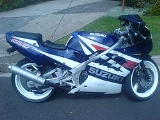
Suzuki GSX-R250
Encyclopedia
The Suzuki GSX-R250 is a motorcycle
that was manufactured from 1987 to 1990 by Suzuki
. A couple of years after the presentation of the GSX-R750 the 250 cc GSX-R250 was released. Like the larger bike, the GSX-R250 had a box-frame (steel, not aluminum), full fairing, Full-floater rear swing and a four-cylinder four-stroke engine. But while the GSX-R750 engine was air and oil-cooled, the baby brother had a liquid-cooled engine. Not many examples are seen outside Japan. 17-inch cast wheels and 300 mm twin disc brake at the front. The GSX-R250 had impressive power and was made primarily as a road legal 250 cc racing bike reaching speeds of 200+km/h (124 mph). Imported specimens may be seen in Australia and New Zealand commonly. Also, around 350 units were imported to Denmark around 1989 to 1992.
Cylinder volume: 248 cc
Bore and stroke: 49,0 x 33,0 mm (1.929 x 1.299 in)
Power output: 45 PS (32.6 kW) at 15,000 RPM
Torque: 24 N·m (17.7 ft·lbf) at 15,000 RPM
Fuel capacity: 16.0 litres (2.0 litres reserve)
Starting system: Electric start
Ignition type: Full transistor
Transmission type: 6-speed constant mesh
Gearshift pattern: 1-down, 5-up
Secondary drive type: Chain
Clutch type: Wet multi-plate
Frame type: Steel box type
Front suspension: Telescopic
Rear suspension: Full-floater
Overall length: 2000 mm (78.7 in)
Overall width: 700 mm (27.6 in)
Overall height: 1105 mm (43.5 in)
Wheelbase: 1370 mm (53.9 in)
Seat height: 770 mm (30.3 in)
Dry weight: 138 kg (304 lb)
Front tyre size: 100/80-17
Rear tyre size: 130/70-17
Front wheel size: 2.50 x 17 in
Rear wheel size: 3.50 x 17 in
Front brake: Dual-piston twin disc, diameter 300 mm (11.81 in)
Rear brake: Single disc, diameter 250 mm (9.84 in)
----
Suzuki year codes in brackets:
Suzuki GSX-R250(H) 1987
Introduced
Suzuki GSX-R250(J) 1988
New graphics
Suzuki GSX-R250(K) 1989
New aluminum frame, upgraded Mikuni carburettors and a staggered wheel setup (with an 18 inch rear wheel and a 17 inch front wheel).
Suzuki GSX-R250(L) 1990
Slightly revised fairings
However they (particularly the CBR250 and ZXR250) were available in the rest of the world as grey market imports.
The same cylinder head, engine block and engine internals were also used by Suzuki to make a more touring-oriented bike - the Suzuki Across
. Amongst some of the differences to the motor, the Across featured less aggressive camshafts and smaller Mikuni carburettors.
Motorcycle
A motorcycle is a single-track, two-wheeled motor vehicle. Motorcycles vary considerably depending on the task for which they are designed, such as long distance travel, navigating congested urban traffic, cruising, sport and racing, or off-road conditions.Motorcycles are one of the most...
that was manufactured from 1987 to 1990 by Suzuki
Suzuki
is a Japanese multinational corporation headquartered in Hamamatsu, Japan that specializes in manufacturing compact automobiles and 4x4 vehicles, a full range of motorcycles, all-terrain vehicles , outboard marine engines, wheelchairs and a variety of other small internal combustion engines...
. A couple of years after the presentation of the GSX-R750 the 250 cc GSX-R250 was released. Like the larger bike, the GSX-R250 had a box-frame (steel, not aluminum), full fairing, Full-floater rear swing and a four-cylinder four-stroke engine. But while the GSX-R750 engine was air and oil-cooled, the baby brother had a liquid-cooled engine. Not many examples are seen outside Japan. 17-inch cast wheels and 300 mm twin disc brake at the front. The GSX-R250 had impressive power and was made primarily as a road legal 250 cc racing bike reaching speeds of 200+km/h (124 mph). Imported specimens may be seen in Australia and New Zealand commonly. Also, around 350 units were imported to Denmark around 1989 to 1992.
Model year 1989 specifications
Engine type: Water-cooled inline-4 DOHC 4-stroke, 16-valveCylinder volume: 248 cc
Bore and stroke: 49,0 x 33,0 mm (1.929 x 1.299 in)
Power output: 45 PS (32.6 kW) at 15,000 RPM
Torque: 24 N·m (17.7 ft·lbf) at 15,000 RPM
Fuel capacity: 16.0 litres (2.0 litres reserve)
Starting system: Electric start
Ignition type: Full transistor
Transmission type: 6-speed constant mesh
Gearshift pattern: 1-down, 5-up
Secondary drive type: Chain
Clutch type: Wet multi-plate
Frame type: Steel box type
Front suspension: Telescopic
Rear suspension: Full-floater
Overall length: 2000 mm (78.7 in)
Overall width: 700 mm (27.6 in)
Overall height: 1105 mm (43.5 in)
Wheelbase: 1370 mm (53.9 in)
Seat height: 770 mm (30.3 in)
Dry weight: 138 kg (304 lb)
Front tyre size: 100/80-17
Rear tyre size: 130/70-17
Front wheel size: 2.50 x 17 in
Rear wheel size: 3.50 x 17 in
Front brake: Dual-piston twin disc, diameter 300 mm (11.81 in)
Rear brake: Single disc, diameter 250 mm (9.84 in)
----
Suzuki year codes in brackets:
Suzuki GSX-R250(H) 1987
Introduced
Suzuki GSX-R250(J) 1988
New graphics
Suzuki GSX-R250(K) 1989
New aluminum frame, upgraded Mikuni carburettors and a staggered wheel setup (with an 18 inch rear wheel and a 17 inch front wheel).
Suzuki GSX-R250(L) 1990
Slightly revised fairings
Similar machines
All four of the major Japanese motorcycle manufacturers produced a sporty, high-revving, 4-cylinder, 4-stroke 250 cc motorcycle capable of producing up to 45 hp (34 kW). They are the Honda CBR250, Kawasaki ZXR250, Suzuki GSX-R250 and the Yamaha FZR250. With limited exceptions, these bikes were generally only officially available in Japan.However they (particularly the CBR250 and ZXR250) were available in the rest of the world as grey market imports.
The same cylinder head, engine block and engine internals were also used by Suzuki to make a more touring-oriented bike - the Suzuki Across
Suzuki Across
Suzuki GSX-250F Across was a small 250 cc engine sport touring motorcycle produced by Suzuki Motor Corporation from 1990 until 1998.It is mostly known as a practical bike, due to its rear petrol tank and a fully enclosed helmet storage area where the petrol tank usually is. It is sometimes...
. Amongst some of the differences to the motor, the Across featured less aggressive camshafts and smaller Mikuni carburettors.

